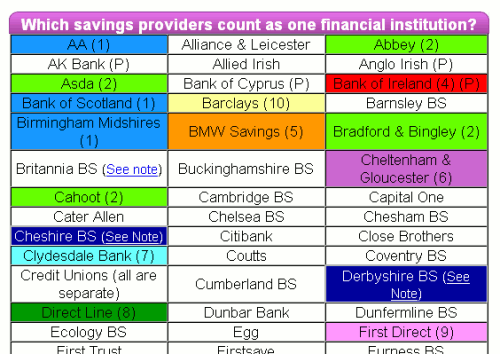This page on MoneySavingExpert. com provides information on the protection offered by the FSCS (Financial Services Compensation Scheme) for UK savers. It outlines what type of savings and investments are covered by the scheme, should your bank or building society collapse. If you are in the fortunate position of having saved more than £50,000 – the maximum amount you would receive under the FSCS should your bank go bust – then you ought to think about spreading your investments across more than one financial institution.
There have been so many mergers in the UK banking sector that it is easy to lose track of who owns whom. To add to the confusion, two banks may have merged but still be registered as separate institutions under the FSA. A table shows you which banks are standalone and which are part of the same institution. Any banks shaded in the same colour (except white) are linked and share protection. If you have money in a combination of linked banks you only receive one lot of the FSCS £50,000 safeguard. For example, if you have £40,000 in Birmingham Midshires and £30,000 in the Bank of Scotland you would only receive £50,000. In contrast NatWest and the Royal Bank of Scotland are at present registered as seperate institutions under the FSA and treated accordingly by the FSCS. If both went under and you had £40,000 in one and £30,000 in the other you would receive £70,000 under the FSCS.

There is basic information on European owned UK banks such as ING Direct, which are treated differently, and links to relevant pages on the FSA and FSCS web sites.
A great bit of info Karen, the linking between banks is not common knowledge amongst the average investor. The consequence in relation to possible compensation claims could be massive.
Now is a time that savers are been forgotten in the midst of crashing interest rates. So whilst savers maybe losing an income it would be unjust for them to also lose their capital.
It needs to be reiterated and will also draw my readers to this issue and refernce your handy chart if ok.
Hi Paul,
I agree – people need to be reminded of these issues.
There was a lot of talk at time of the Northern Rock and Icesave failures about the limits of the FSCS scheme. Now I fear that many people may be forgetting to check ownership of their bank or building society in the search for better savings rates. I suspect that many also do not realise that banks such as ING Direct are covered by a different compensation scheme and that they would have to claim from the government of the country supervising that bank. In the case of ING Direct that would be the Netherlands.
The full table of institutions is on http://www.moneysavingexpert.com/savings/safe-savings#whatcounts so please point your readers to that link.
Regards
Karen
Excellent article, I knew some of the banks were linked but it always seemed like a closely guarded secret. In the current climate it has such a potential impact, everyone needs to know.
You could have a mortgage and savings with the same bank, and another account with what you considered totally independent, but actually it was linked and then you’d only qualify for one amount should the worst happen.
Thanks for getting us thinking.